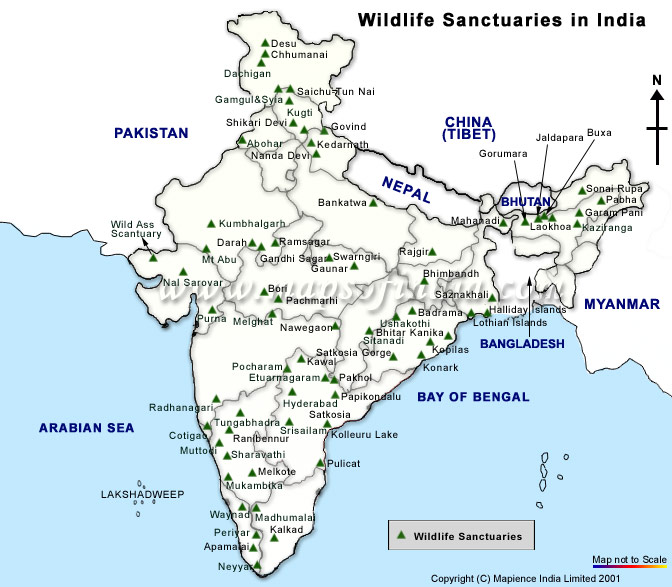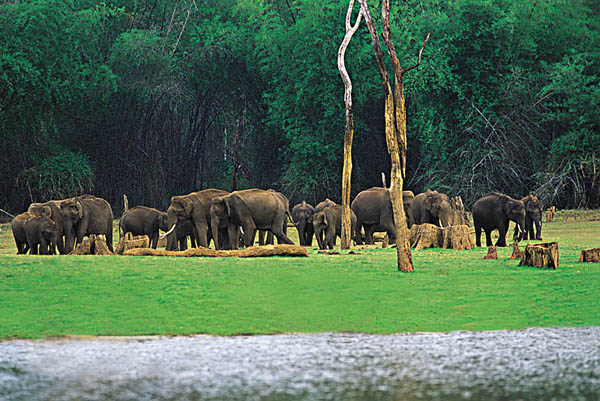Periyar Wildlife Sanctuary
Periyar is a protected area, and a nature reserve in the South Indian State of Kerala, set high in the mountains of the Western Ghats along the border with Tamil Nadu. It lies in the districts of Idukki and Pathanamthitta. The protected area covers an area of 925 km², out of which a 350 km² part of the core zone was made into the Periyar National Park and Tiger Reserve, sometimes dubbed the Periyar Wildlife Sanctuary. The park is often referred to by the name "Thekkady". Thekkady is located four km from Kumily, approximately 100 km east ofKottayam, 110 km west of Madurai and 120 km southeast from Kochi.
Periyar Wildlife Sanctuary Map


Geography
The Periyar protected area lies in the middle of a mountainous area of the Cardamom Hills. In the north and the east it is bounded by mountain ridges of over 1,700 m (5,600 ft) altitude and toward the west it expands into a 1,200 metres (3,900 ft) high plateau. From this level the altitude drops steeply to the deepest point of the reserve, the 100 meter valley of the Pamba River. The highest peak is the 2,019 m (6,624 ft) highKottamalai.
The sanctuary surrounds picturesque 26 km2 (10 sq mi) Periyar lake, formed by the building of Mullaperiyar Dam in 1895. This reservoir and thePeriyar River meander around the contours of the wooded hills, providing a permanent source of water for the local wildlife.
| Location | Idukki, India |
|---|---|
| Nearest city | Kochi, India |
| Coordinates | 9°28′0″N 77°10′0″ECoordinates: 9°28′0″N 77°10′0″E |
| Area | 305 km² |
| Established | 1982 |
| Visitors | 180,000 (in 1986) |
Climate
The temperature varies depending upon the altitude and it ranges between 15° Celsius in December and January and 31° Celsius in April and May. The annual amount of precipitation lies between 2000 and 3000 mm. About two thirds of the precipitation occurs during the southwest monsoon between June to September. A smaller amount of precipitation occurs during the northeast monsoon between October and December.
Vegetation
Approximately 75% of the entire protected area are covered of unaffected evergreen or semi-evergreen rain forest. There typically tall tropical tree species such as Vateria indica, Cullenia exarillata, Hopea parviflora, Canarium strictum, Artocarpus hirsutus and Bischofia javanica are seen. They reach heights of 40 to 50 Metres.
Scarcely 13% consists of damp leaves forest, 7% of Eucalyptus plantation and 1.5% of grassland. The remainder (around 3.5%) of the protected area is covered by the Periyar artificial lake as well as the Periyar River and Pamba rivers.
Altogether the reservation counts nearly 2000 kinds of flowering plants (Angiosperms), three kinds of seed plants (gymnosperms) and 170 different species offerns. Among the Angiosperms, there are 169 families of sweet grasses and 155 kinds of Fabaceae. Orchids, with 145 representative types, are the most frequent flower.
About 350 of the occurring plant types can be used for medical purposes.

Kerala Forest Department sign, located at the Information Centre.
Fauna
Mammals
This place is famous for elephant. Altogether 62 different kinds of mammal have been recorded in Periyar, including many threatened ones. Periyar is a highly protected tiger reserve and elephant reserve. There are an estimated 53 tigers (2010) in the reserve. Tourists also come here to view the Indian elephants in the act of ablution and playfulness by the Periyar lake. The elephant number around 900 to 1000 individuals. Other mammals found here includegaur, Bison, sambar (horse deer), barking deer, mouse deer, Dholes (Indian wild dogs), mongoose, foxes and leopards. Also inhabiting the park, though rarely seen, are the elusive Nilgiri tahr.
Four species of primates are found at Periyar - the rare lion-tailed macaque, the Nilgiri Langur, the common langur, and the Bonnet Macaque.
Birds
So far 320 different kinds have been counted in Periyar. The bird life includes darters, cormorants, kingfishers, the great Malabar hornbill and racket-tailed Drongos.
Reptiles
There are 45 different kinds of reptile in the protected area out of which there are 30 snake, two turtle, and 13 lizard species. Among those are Monitor lizardsthat can be spotted basking in the sun on the rocks along the lake shore. Visitors who trek into the Periyar national park often see a Python and sometimes even a King Cobra.
Amphibians
Twenty seven different kinds have been recorded, of which ten are endemic to the Western Ghats, such as some species of frogs and cecilians.
Fish
In the waters of the protected area 38 different fish types live, of which four are endemic to the Western Ghats.Salmon,trout is also here.
Insects
There is a remarkable variety of butterflies and there are about 160 different kinds in total. Some are dangerous enough to make a human seriously ill
History
1895 - Construction of the Mullaperiyar Dam
1899 - Formation of the Periyar Lake Reserve
1933 - S.C.H. Robinson made the first game warden
1934 - Formation of Nellikkampatty Game Sanctuary
1950 - Consolidation of Periyar as a Wildlife sanctuary
1978 - Declaration of Periyar as a Tiger Reserve
1982 - Preliminary notification of the core area as a National Park
1991 - Brought under Project Elephant
1996 - India Ecodevelopment Project launched
2001 - Reorganised as two Divisions: Periyar East and Periyar West
Tourists and Pilgrims
The Periyar tiger reserve is considered as one of the best managed reserve in India . The core zone of the park is not accessible to the tourists. Within the buffer zone of 430 km², a zone of 55 km² is kept apart for tourism. Game wardens and staff have been recently spotted illegally fishing and gathering specimens within the sanctuary area. The facilities within the sanctuary are in need of much maintenance and are presently in very poor standards. This has also contributed a steady decline in returning tourists to the sanctuary.
In the buffer zone there is also the temple of Sabarimala, which is visited by about 4 million pilgrims annually.
Its important to recognize, however, that for the very purpose of protecting its wildlife and shielding them from human interference, Periyar National Park allows extremely limited access to the territory under its jurisdiction, restricting tourist entry only to the northern corner adjacent to man-made lake Periyar.



No comments:
Post a Comment